University Business Law: BUS2010 Tort Law Case Analysis, Part 2
VerifiedAdded on 2022/10/18
|12
|2183
|15
Case Study
AI Summary
This case study delves into a complex business law scenario involving torts, focusing on the legal ramifications faced by Max and Luke. The analysis covers various aspects of tort law, including the definition of torts, the distinction between tort and criminal law, and specific torts such as passing off, interference with contractual relations, and defamation. The case also examines employment law, including restrictive covenants, and trespass. Furthermore, the analysis explores negligence claims, outlining the elements necessary to establish negligence and the potential remedies available to the plaintiffs. The document includes relevant legal precedents and legislation, providing a comprehensive understanding of the legal issues involved. The case study evaluates the steps in a negligence action including duty, breach, causation, and damages, providing a clear understanding of the process.
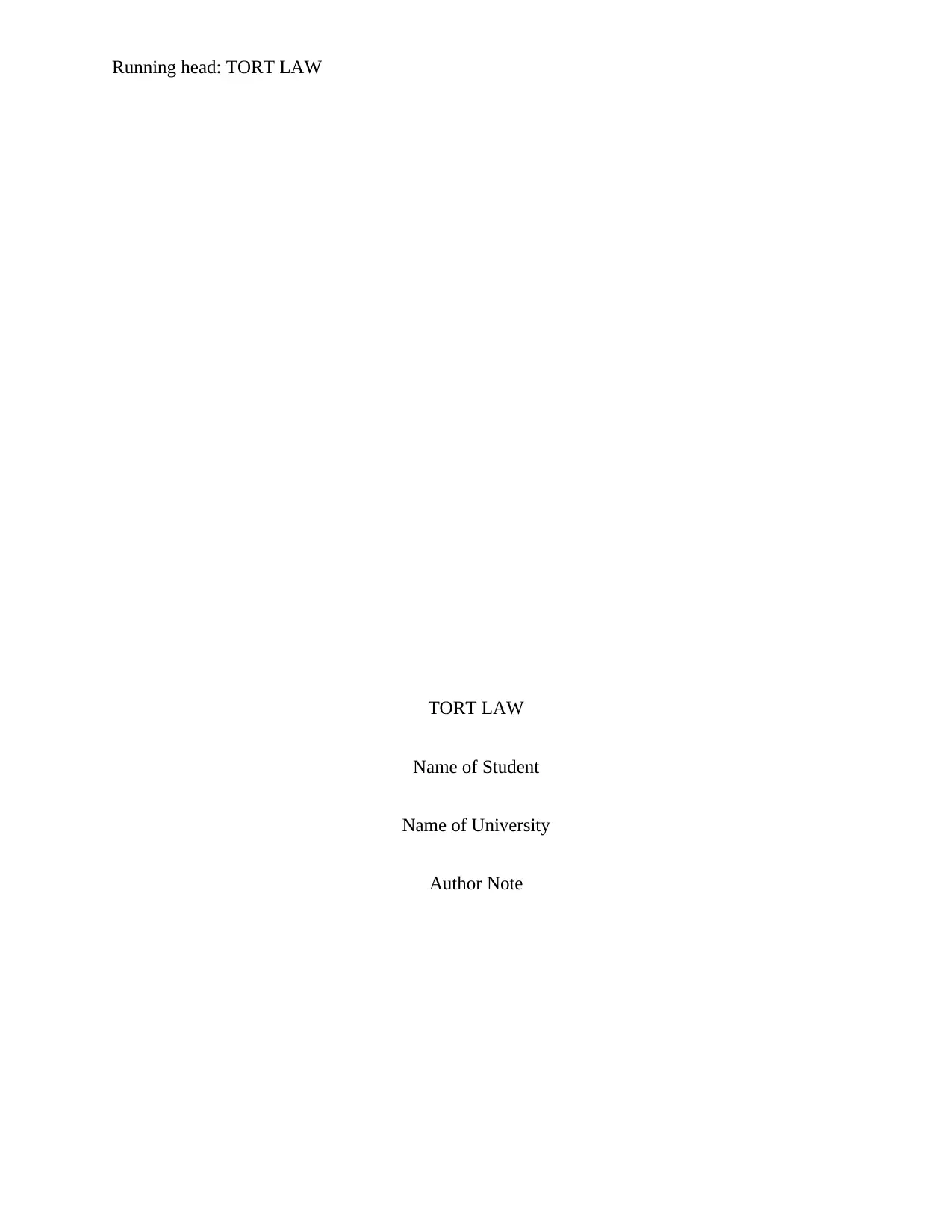
Running head: TORT LAW
TORT LAW
Name of Student
Name of University
Author Note
TORT LAW
Name of Student
Name of University
Author Note
Paraphrase This Document
Need a fresh take? Get an instant paraphrase of this document with our AI Paraphraser

1TORT LAW
Table of Contents
Answer 1..........................................................................................................................................2
Answer 2..........................................................................................................................................3
Answer 3..........................................................................................................................................4
Answer 4..........................................................................................................................................5
Answer 5..........................................................................................................................................6
Answer 6..........................................................................................................................................6
Answer 7..........................................................................................................................................7
Answer 8..........................................................................................................................................7
Answer 9..........................................................................................................................................8
Answer 10........................................................................................................................................9
Reference.......................................................................................................................................10
Table of Contents
Answer 1..........................................................................................................................................2
Answer 2..........................................................................................................................................3
Answer 3..........................................................................................................................................4
Answer 4..........................................................................................................................................5
Answer 5..........................................................................................................................................6
Answer 6..........................................................................................................................................6
Answer 7..........................................................................................................................................7
Answer 8..........................................................................................................................................7
Answer 9..........................................................................................................................................8
Answer 10........................................................................................................................................9
Reference.......................................................................................................................................10
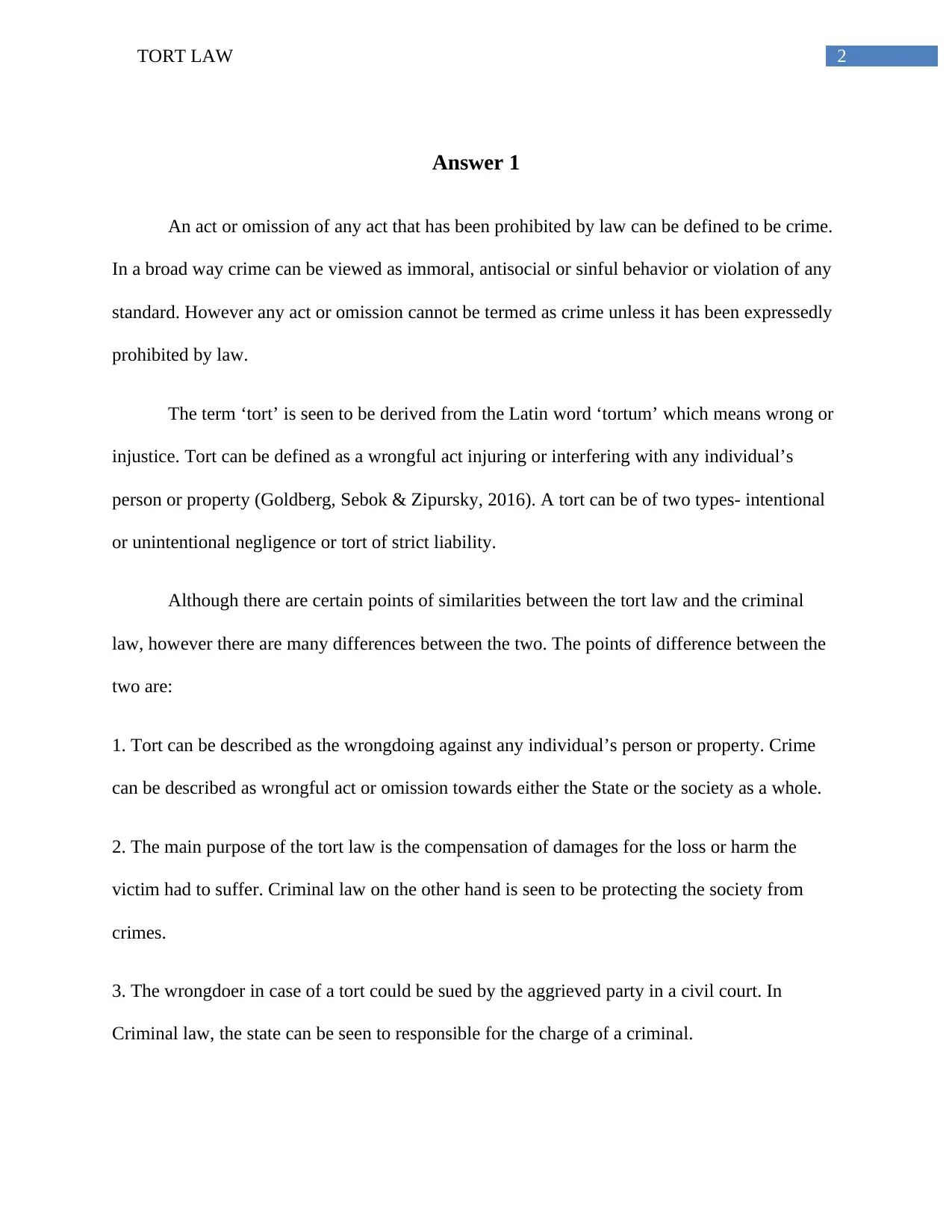
2TORT LAW
Answer 1
An act or omission of any act that has been prohibited by law can be defined to be crime.
In a broad way crime can be viewed as immoral, antisocial or sinful behavior or violation of any
standard. However any act or omission cannot be termed as crime unless it has been expressedly
prohibited by law.
The term ‘tort’ is seen to be derived from the Latin word ‘tortum’ which means wrong or
injustice. Tort can be defined as a wrongful act injuring or interfering with any individual’s
person or property (Goldberg, Sebok & Zipursky, 2016). A tort can be of two types- intentional
or unintentional negligence or tort of strict liability.
Although there are certain points of similarities between the tort law and the criminal
law, however there are many differences between the two. The points of difference between the
two are:
1. Tort can be described as the wrongdoing against any individual’s person or property. Crime
can be described as wrongful act or omission towards either the State or the society as a whole.
2. The main purpose of the tort law is the compensation of damages for the loss or harm the
victim had to suffer. Criminal law on the other hand is seen to be protecting the society from
crimes.
3. The wrongdoer in case of a tort could be sued by the aggrieved party in a civil court. In
Criminal law, the state can be seen to responsible for the charge of a criminal.
Answer 1
An act or omission of any act that has been prohibited by law can be defined to be crime.
In a broad way crime can be viewed as immoral, antisocial or sinful behavior or violation of any
standard. However any act or omission cannot be termed as crime unless it has been expressedly
prohibited by law.
The term ‘tort’ is seen to be derived from the Latin word ‘tortum’ which means wrong or
injustice. Tort can be defined as a wrongful act injuring or interfering with any individual’s
person or property (Goldberg, Sebok & Zipursky, 2016). A tort can be of two types- intentional
or unintentional negligence or tort of strict liability.
Although there are certain points of similarities between the tort law and the criminal
law, however there are many differences between the two. The points of difference between the
two are:
1. Tort can be described as the wrongdoing against any individual’s person or property. Crime
can be described as wrongful act or omission towards either the State or the society as a whole.
2. The main purpose of the tort law is the compensation of damages for the loss or harm the
victim had to suffer. Criminal law on the other hand is seen to be protecting the society from
crimes.
3. The wrongdoer in case of a tort could be sued by the aggrieved party in a civil court. In
Criminal law, the state can be seen to responsible for the charge of a criminal.
⊘ This is a preview!⊘
Do you want full access?
Subscribe today to unlock all pages.

Trusted by 1+ million students worldwide
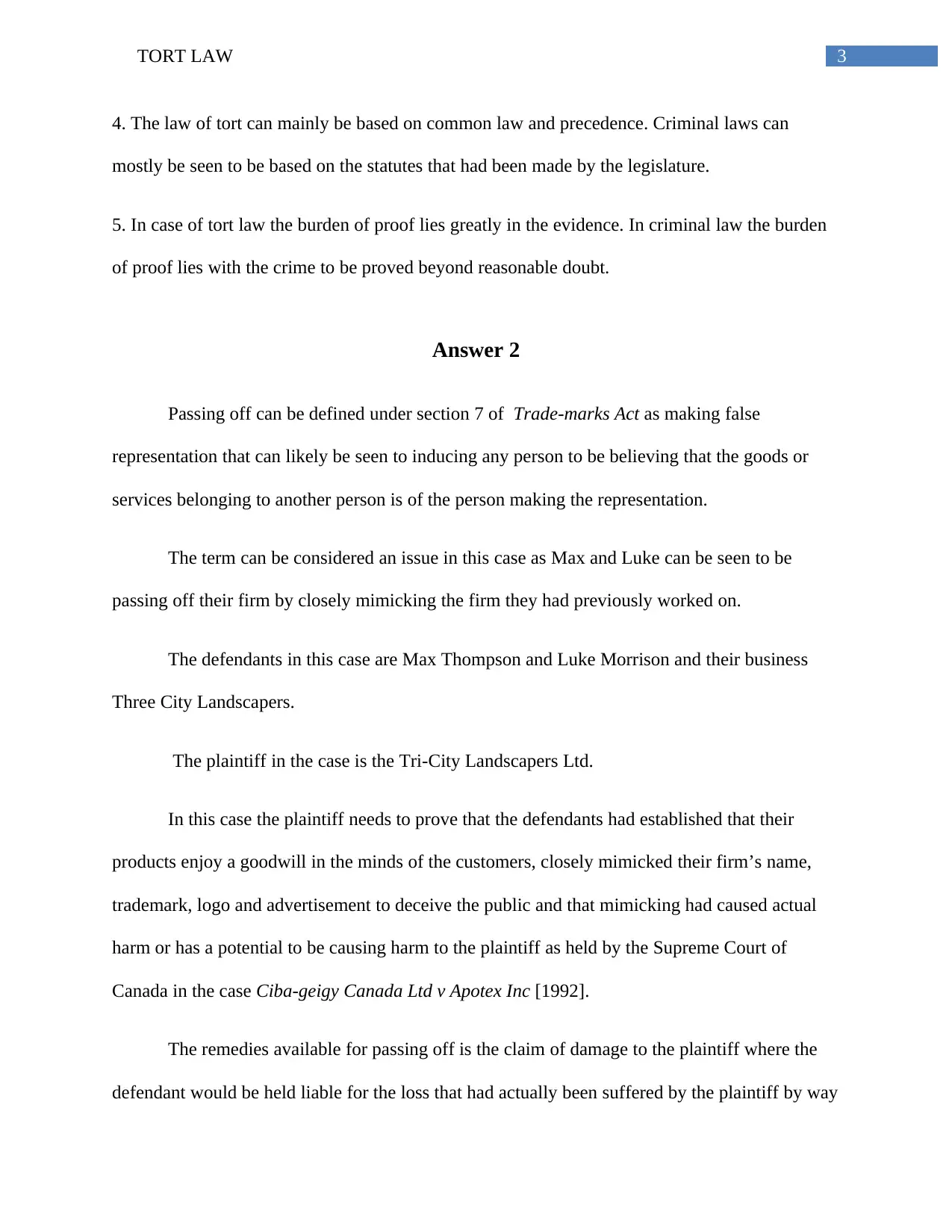
3TORT LAW
4. The law of tort can mainly be based on common law and precedence. Criminal laws can
mostly be seen to be based on the statutes that had been made by the legislature.
5. In case of tort law the burden of proof lies greatly in the evidence. In criminal law the burden
of proof lies with the crime to be proved beyond reasonable doubt.
Answer 2
Passing off can be defined under section 7 of Trade-marks Act as making false
representation that can likely be seen to inducing any person to be believing that the goods or
services belonging to another person is of the person making the representation.
The term can be considered an issue in this case as Max and Luke can be seen to be
passing off their firm by closely mimicking the firm they had previously worked on.
The defendants in this case are Max Thompson and Luke Morrison and their business
Three City Landscapers.
The plaintiff in the case is the Tri-City Landscapers Ltd.
In this case the plaintiff needs to prove that the defendants had established that their
products enjoy a goodwill in the minds of the customers, closely mimicked their firm’s name,
trademark, logo and advertisement to deceive the public and that mimicking had caused actual
harm or has a potential to be causing harm to the plaintiff as held by the Supreme Court of
Canada in the case Ciba-geigy Canada Ltd v Apotex Inc [1992].
The remedies available for passing off is the claim of damage to the plaintiff where the
defendant would be held liable for the loss that had actually been suffered by the plaintiff by way
4. The law of tort can mainly be based on common law and precedence. Criminal laws can
mostly be seen to be based on the statutes that had been made by the legislature.
5. In case of tort law the burden of proof lies greatly in the evidence. In criminal law the burden
of proof lies with the crime to be proved beyond reasonable doubt.
Answer 2
Passing off can be defined under section 7 of Trade-marks Act as making false
representation that can likely be seen to inducing any person to be believing that the goods or
services belonging to another person is of the person making the representation.
The term can be considered an issue in this case as Max and Luke can be seen to be
passing off their firm by closely mimicking the firm they had previously worked on.
The defendants in this case are Max Thompson and Luke Morrison and their business
Three City Landscapers.
The plaintiff in the case is the Tri-City Landscapers Ltd.
In this case the plaintiff needs to prove that the defendants had established that their
products enjoy a goodwill in the minds of the customers, closely mimicked their firm’s name,
trademark, logo and advertisement to deceive the public and that mimicking had caused actual
harm or has a potential to be causing harm to the plaintiff as held by the Supreme Court of
Canada in the case Ciba-geigy Canada Ltd v Apotex Inc [1992].
The remedies available for passing off is the claim of damage to the plaintiff where the
defendant would be held liable for the loss that had actually been suffered by the plaintiff by way
Paraphrase This Document
Need a fresh take? Get an instant paraphrase of this document with our AI Paraphraser
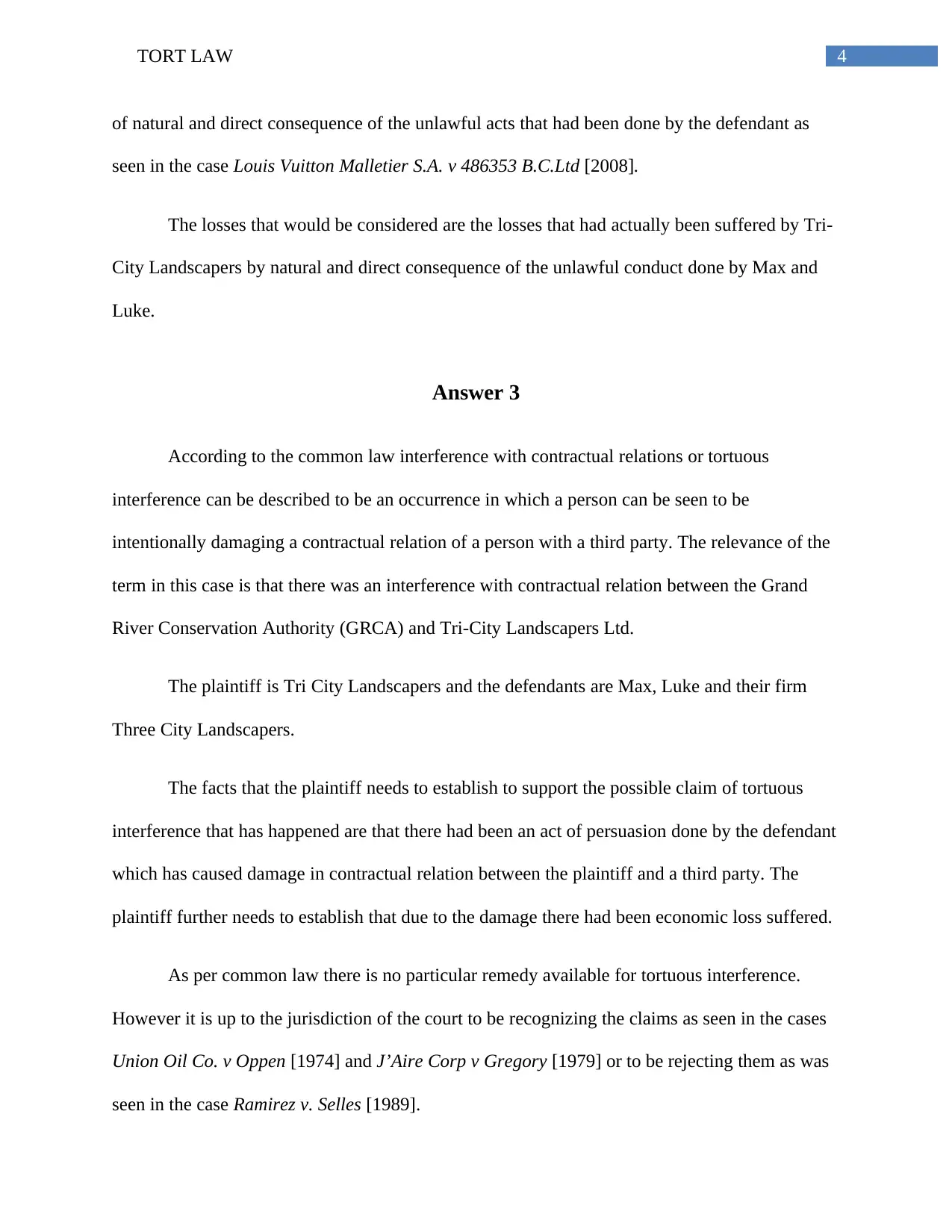
4TORT LAW
of natural and direct consequence of the unlawful acts that had been done by the defendant as
seen in the case Louis Vuitton Malletier S.A. v 486353 B.C.Ltd [2008].
The losses that would be considered are the losses that had actually been suffered by Tri-
City Landscapers by natural and direct consequence of the unlawful conduct done by Max and
Luke.
Answer 3
According to the common law interference with contractual relations or tortuous
interference can be described to be an occurrence in which a person can be seen to be
intentionally damaging a contractual relation of a person with a third party. The relevance of the
term in this case is that there was an interference with contractual relation between the Grand
River Conservation Authority (GRCA) and Tri-City Landscapers Ltd.
The plaintiff is Tri City Landscapers and the defendants are Max, Luke and their firm
Three City Landscapers.
The facts that the plaintiff needs to establish to support the possible claim of tortuous
interference that has happened are that there had been an act of persuasion done by the defendant
which has caused damage in contractual relation between the plaintiff and a third party. The
plaintiff further needs to establish that due to the damage there had been economic loss suffered.
As per common law there is no particular remedy available for tortuous interference.
However it is up to the jurisdiction of the court to be recognizing the claims as seen in the cases
Union Oil Co. v Oppen [1974] and J’Aire Corp v Gregory [1979] or to be rejecting them as was
seen in the case Ramirez v. Selles [1989].
of natural and direct consequence of the unlawful acts that had been done by the defendant as
seen in the case Louis Vuitton Malletier S.A. v 486353 B.C.Ltd [2008].
The losses that would be considered are the losses that had actually been suffered by Tri-
City Landscapers by natural and direct consequence of the unlawful conduct done by Max and
Luke.
Answer 3
According to the common law interference with contractual relations or tortuous
interference can be described to be an occurrence in which a person can be seen to be
intentionally damaging a contractual relation of a person with a third party. The relevance of the
term in this case is that there was an interference with contractual relation between the Grand
River Conservation Authority (GRCA) and Tri-City Landscapers Ltd.
The plaintiff is Tri City Landscapers and the defendants are Max, Luke and their firm
Three City Landscapers.
The facts that the plaintiff needs to establish to support the possible claim of tortuous
interference that has happened are that there had been an act of persuasion done by the defendant
which has caused damage in contractual relation between the plaintiff and a third party. The
plaintiff further needs to establish that due to the damage there had been economic loss suffered.
As per common law there is no particular remedy available for tortuous interference.
However it is up to the jurisdiction of the court to be recognizing the claims as seen in the cases
Union Oil Co. v Oppen [1974] and J’Aire Corp v Gregory [1979] or to be rejecting them as was
seen in the case Ramirez v. Selles [1989].
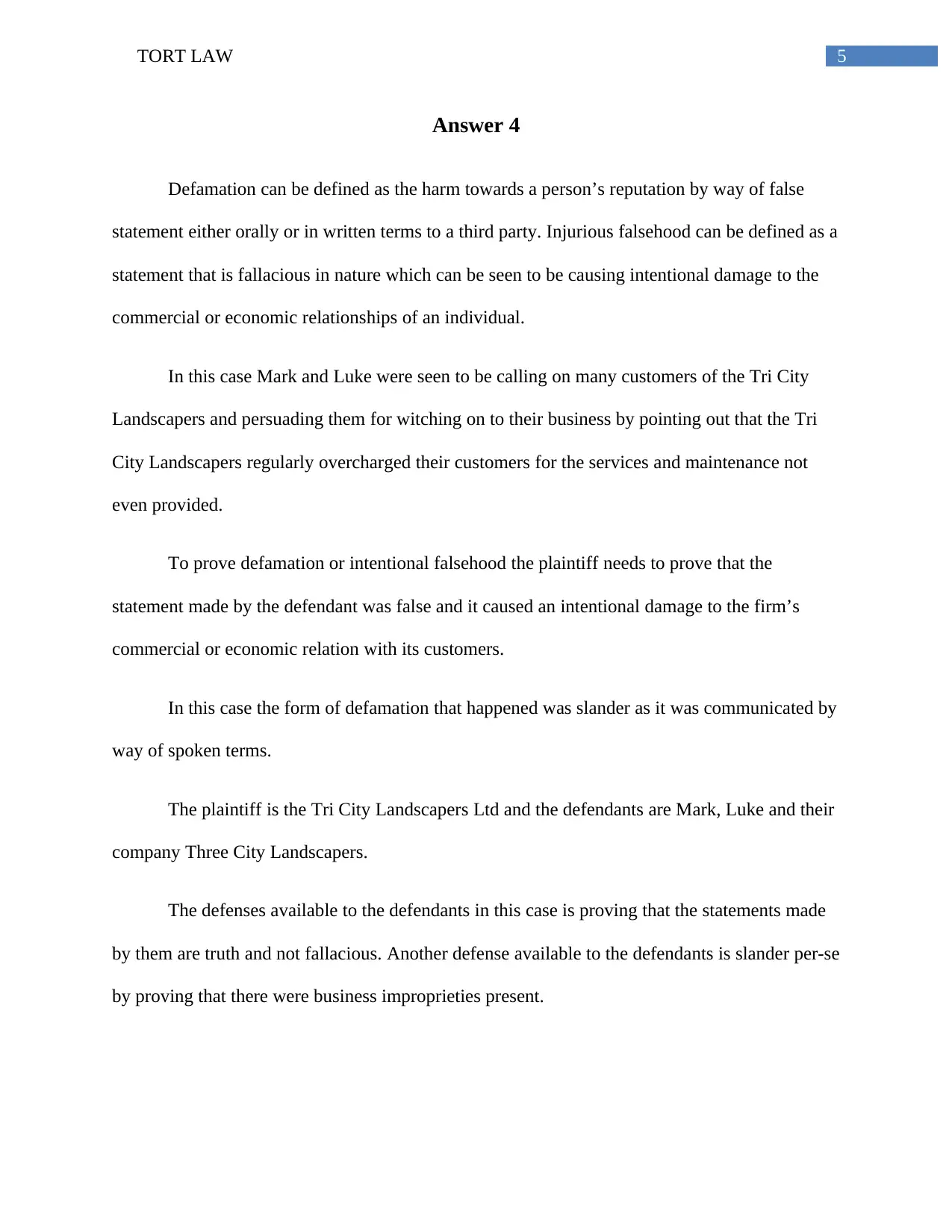
5TORT LAW
Answer 4
Defamation can be defined as the harm towards a person’s reputation by way of false
statement either orally or in written terms to a third party. Injurious falsehood can be defined as a
statement that is fallacious in nature which can be seen to be causing intentional damage to the
commercial or economic relationships of an individual.
In this case Mark and Luke were seen to be calling on many customers of the Tri City
Landscapers and persuading them for witching on to their business by pointing out that the Tri
City Landscapers regularly overcharged their customers for the services and maintenance not
even provided.
To prove defamation or intentional falsehood the plaintiff needs to prove that the
statement made by the defendant was false and it caused an intentional damage to the firm’s
commercial or economic relation with its customers.
In this case the form of defamation that happened was slander as it was communicated by
way of spoken terms.
The plaintiff is the Tri City Landscapers Ltd and the defendants are Mark, Luke and their
company Three City Landscapers.
The defenses available to the defendants in this case is proving that the statements made
by them are truth and not fallacious. Another defense available to the defendants is slander per-se
by proving that there were business improprieties present.
Answer 4
Defamation can be defined as the harm towards a person’s reputation by way of false
statement either orally or in written terms to a third party. Injurious falsehood can be defined as a
statement that is fallacious in nature which can be seen to be causing intentional damage to the
commercial or economic relationships of an individual.
In this case Mark and Luke were seen to be calling on many customers of the Tri City
Landscapers and persuading them for witching on to their business by pointing out that the Tri
City Landscapers regularly overcharged their customers for the services and maintenance not
even provided.
To prove defamation or intentional falsehood the plaintiff needs to prove that the
statement made by the defendant was false and it caused an intentional damage to the firm’s
commercial or economic relation with its customers.
In this case the form of defamation that happened was slander as it was communicated by
way of spoken terms.
The plaintiff is the Tri City Landscapers Ltd and the defendants are Mark, Luke and their
company Three City Landscapers.
The defenses available to the defendants in this case is proving that the statements made
by them are truth and not fallacious. Another defense available to the defendants is slander per-se
by proving that there were business improprieties present.
⊘ This is a preview!⊘
Do you want full access?
Subscribe today to unlock all pages.

Trusted by 1+ million students worldwide
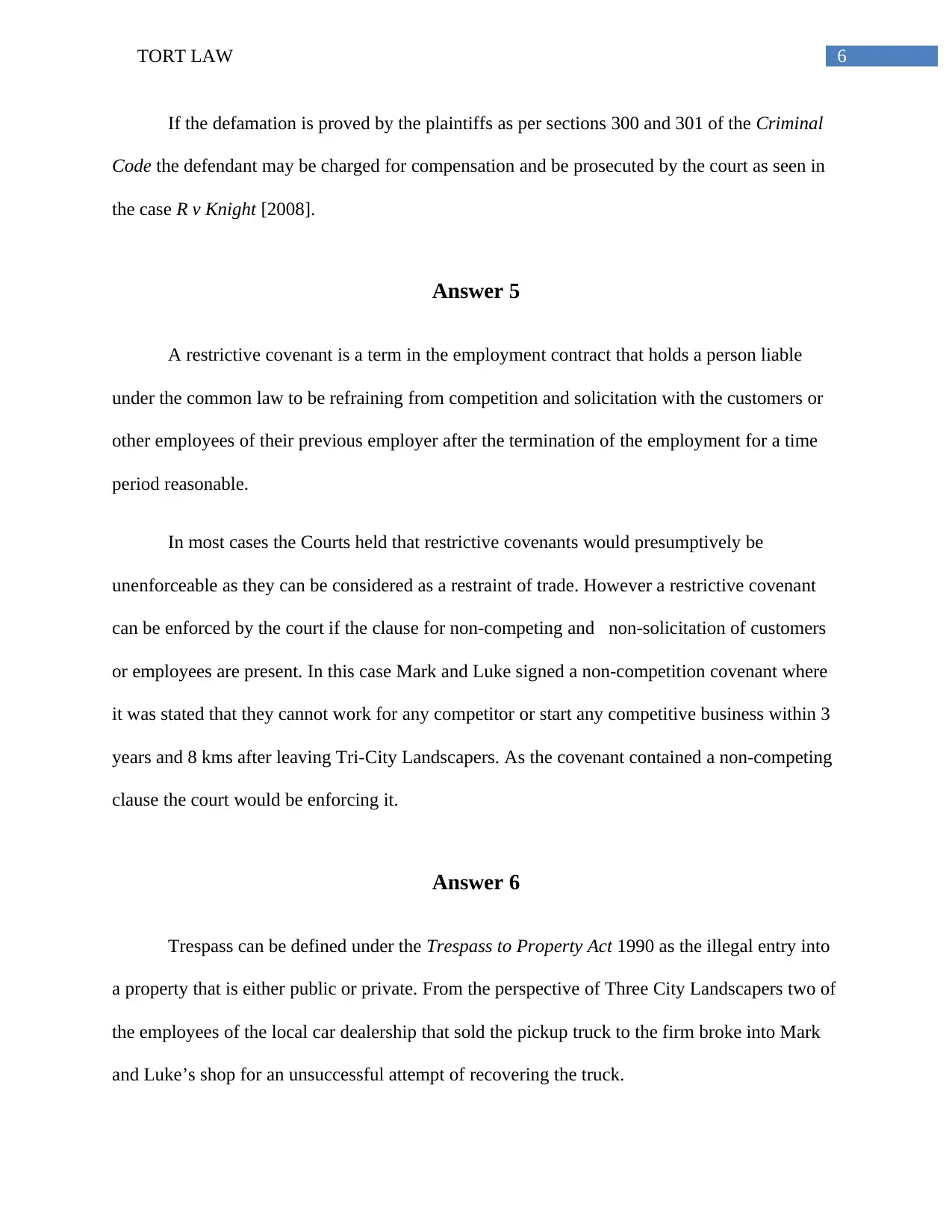
6TORT LAW
If the defamation is proved by the plaintiffs as per sections 300 and 301 of the Criminal
Code the defendant may be charged for compensation and be prosecuted by the court as seen in
the case R v Knight [2008].
Answer 5
A restrictive covenant is a term in the employment contract that holds a person liable
under the common law to be refraining from competition and solicitation with the customers or
other employees of their previous employer after the termination of the employment for a time
period reasonable.
In most cases the Courts held that restrictive covenants would presumptively be
unenforceable as they can be considered as a restraint of trade. However a restrictive covenant
can be enforced by the court if the clause for non-competing and non-solicitation of customers
or employees are present. In this case Mark and Luke signed a non-competition covenant where
it was stated that they cannot work for any competitor or start any competitive business within 3
years and 8 kms after leaving Tri-City Landscapers. As the covenant contained a non-competing
clause the court would be enforcing it.
Answer 6
Trespass can be defined under the Trespass to Property Act 1990 as the illegal entry into
a property that is either public or private. From the perspective of Three City Landscapers two of
the employees of the local car dealership that sold the pickup truck to the firm broke into Mark
and Luke’s shop for an unsuccessful attempt of recovering the truck.
If the defamation is proved by the plaintiffs as per sections 300 and 301 of the Criminal
Code the defendant may be charged for compensation and be prosecuted by the court as seen in
the case R v Knight [2008].
Answer 5
A restrictive covenant is a term in the employment contract that holds a person liable
under the common law to be refraining from competition and solicitation with the customers or
other employees of their previous employer after the termination of the employment for a time
period reasonable.
In most cases the Courts held that restrictive covenants would presumptively be
unenforceable as they can be considered as a restraint of trade. However a restrictive covenant
can be enforced by the court if the clause for non-competing and non-solicitation of customers
or employees are present. In this case Mark and Luke signed a non-competition covenant where
it was stated that they cannot work for any competitor or start any competitive business within 3
years and 8 kms after leaving Tri-City Landscapers. As the covenant contained a non-competing
clause the court would be enforcing it.
Answer 6
Trespass can be defined under the Trespass to Property Act 1990 as the illegal entry into
a property that is either public or private. From the perspective of Three City Landscapers two of
the employees of the local car dealership that sold the pickup truck to the firm broke into Mark
and Luke’s shop for an unsuccessful attempt of recovering the truck.
Paraphrase This Document
Need a fresh take? Get an instant paraphrase of this document with our AI Paraphraser
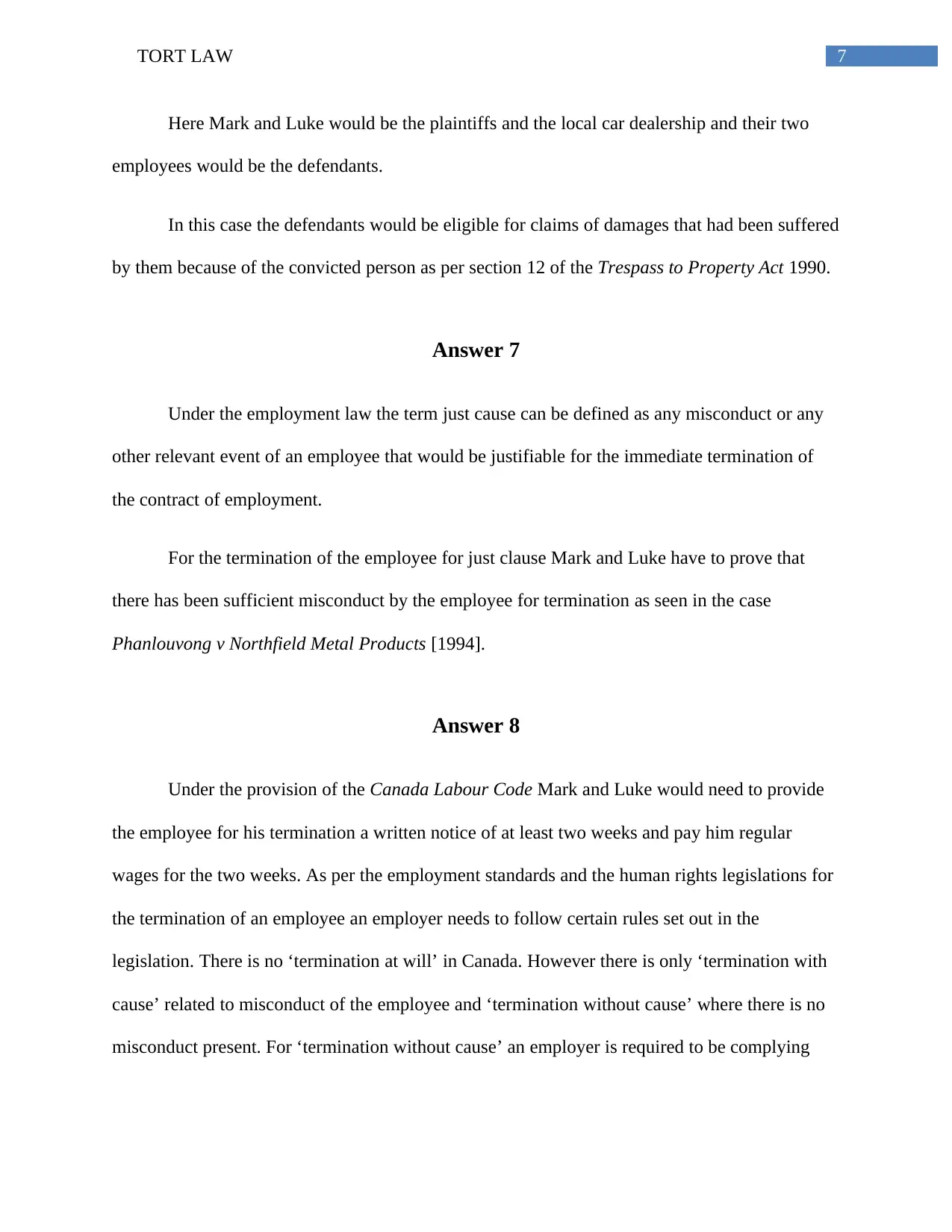
7TORT LAW
Here Mark and Luke would be the plaintiffs and the local car dealership and their two
employees would be the defendants.
In this case the defendants would be eligible for claims of damages that had been suffered
by them because of the convicted person as per section 12 of the Trespass to Property Act 1990.
Answer 7
Under the employment law the term just cause can be defined as any misconduct or any
other relevant event of an employee that would be justifiable for the immediate termination of
the contract of employment.
For the termination of the employee for just clause Mark and Luke have to prove that
there has been sufficient misconduct by the employee for termination as seen in the case
Phanlouvong v Northfield Metal Products [1994].
Answer 8
Under the provision of the Canada Labour Code Mark and Luke would need to provide
the employee for his termination a written notice of at least two weeks and pay him regular
wages for the two weeks. As per the employment standards and the human rights legislations for
the termination of an employee an employer needs to follow certain rules set out in the
legislation. There is no ‘termination at will’ in Canada. However there is only ‘termination with
cause’ related to misconduct of the employee and ‘termination without cause’ where there is no
misconduct present. For ‘termination without cause’ an employer is required to be complying
Here Mark and Luke would be the plaintiffs and the local car dealership and their two
employees would be the defendants.
In this case the defendants would be eligible for claims of damages that had been suffered
by them because of the convicted person as per section 12 of the Trespass to Property Act 1990.
Answer 7
Under the employment law the term just cause can be defined as any misconduct or any
other relevant event of an employee that would be justifiable for the immediate termination of
the contract of employment.
For the termination of the employee for just clause Mark and Luke have to prove that
there has been sufficient misconduct by the employee for termination as seen in the case
Phanlouvong v Northfield Metal Products [1994].
Answer 8
Under the provision of the Canada Labour Code Mark and Luke would need to provide
the employee for his termination a written notice of at least two weeks and pay him regular
wages for the two weeks. As per the employment standards and the human rights legislations for
the termination of an employee an employer needs to follow certain rules set out in the
legislation. There is no ‘termination at will’ in Canada. However there is only ‘termination with
cause’ related to misconduct of the employee and ‘termination without cause’ where there is no
misconduct present. For ‘termination without cause’ an employer is required to be complying
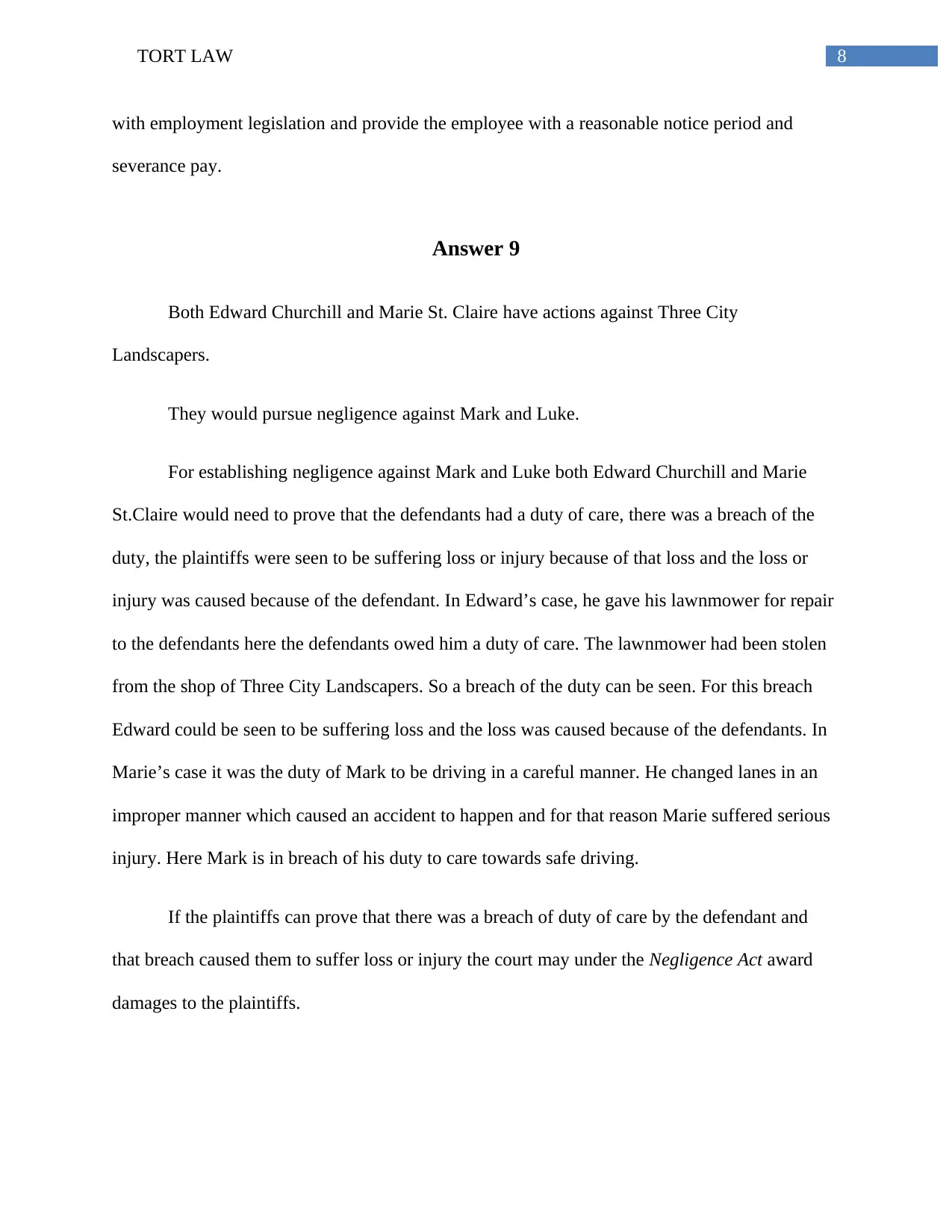
8TORT LAW
with employment legislation and provide the employee with a reasonable notice period and
severance pay.
Answer 9
Both Edward Churchill and Marie St. Claire have actions against Three City
Landscapers.
They would pursue negligence against Mark and Luke.
For establishing negligence against Mark and Luke both Edward Churchill and Marie
St.Claire would need to prove that the defendants had a duty of care, there was a breach of the
duty, the plaintiffs were seen to be suffering loss or injury because of that loss and the loss or
injury was caused because of the defendant. In Edward’s case, he gave his lawnmower for repair
to the defendants here the defendants owed him a duty of care. The lawnmower had been stolen
from the shop of Three City Landscapers. So a breach of the duty can be seen. For this breach
Edward could be seen to be suffering loss and the loss was caused because of the defendants. In
Marie’s case it was the duty of Mark to be driving in a careful manner. He changed lanes in an
improper manner which caused an accident to happen and for that reason Marie suffered serious
injury. Here Mark is in breach of his duty to care towards safe driving.
If the plaintiffs can prove that there was a breach of duty of care by the defendant and
that breach caused them to suffer loss or injury the court may under the Negligence Act award
damages to the plaintiffs.
with employment legislation and provide the employee with a reasonable notice period and
severance pay.
Answer 9
Both Edward Churchill and Marie St. Claire have actions against Three City
Landscapers.
They would pursue negligence against Mark and Luke.
For establishing negligence against Mark and Luke both Edward Churchill and Marie
St.Claire would need to prove that the defendants had a duty of care, there was a breach of the
duty, the plaintiffs were seen to be suffering loss or injury because of that loss and the loss or
injury was caused because of the defendant. In Edward’s case, he gave his lawnmower for repair
to the defendants here the defendants owed him a duty of care. The lawnmower had been stolen
from the shop of Three City Landscapers. So a breach of the duty can be seen. For this breach
Edward could be seen to be suffering loss and the loss was caused because of the defendants. In
Marie’s case it was the duty of Mark to be driving in a careful manner. He changed lanes in an
improper manner which caused an accident to happen and for that reason Marie suffered serious
injury. Here Mark is in breach of his duty to care towards safe driving.
If the plaintiffs can prove that there was a breach of duty of care by the defendant and
that breach caused them to suffer loss or injury the court may under the Negligence Act award
damages to the plaintiffs.
⊘ This is a preview!⊘
Do you want full access?
Subscribe today to unlock all pages.

Trusted by 1+ million students worldwide
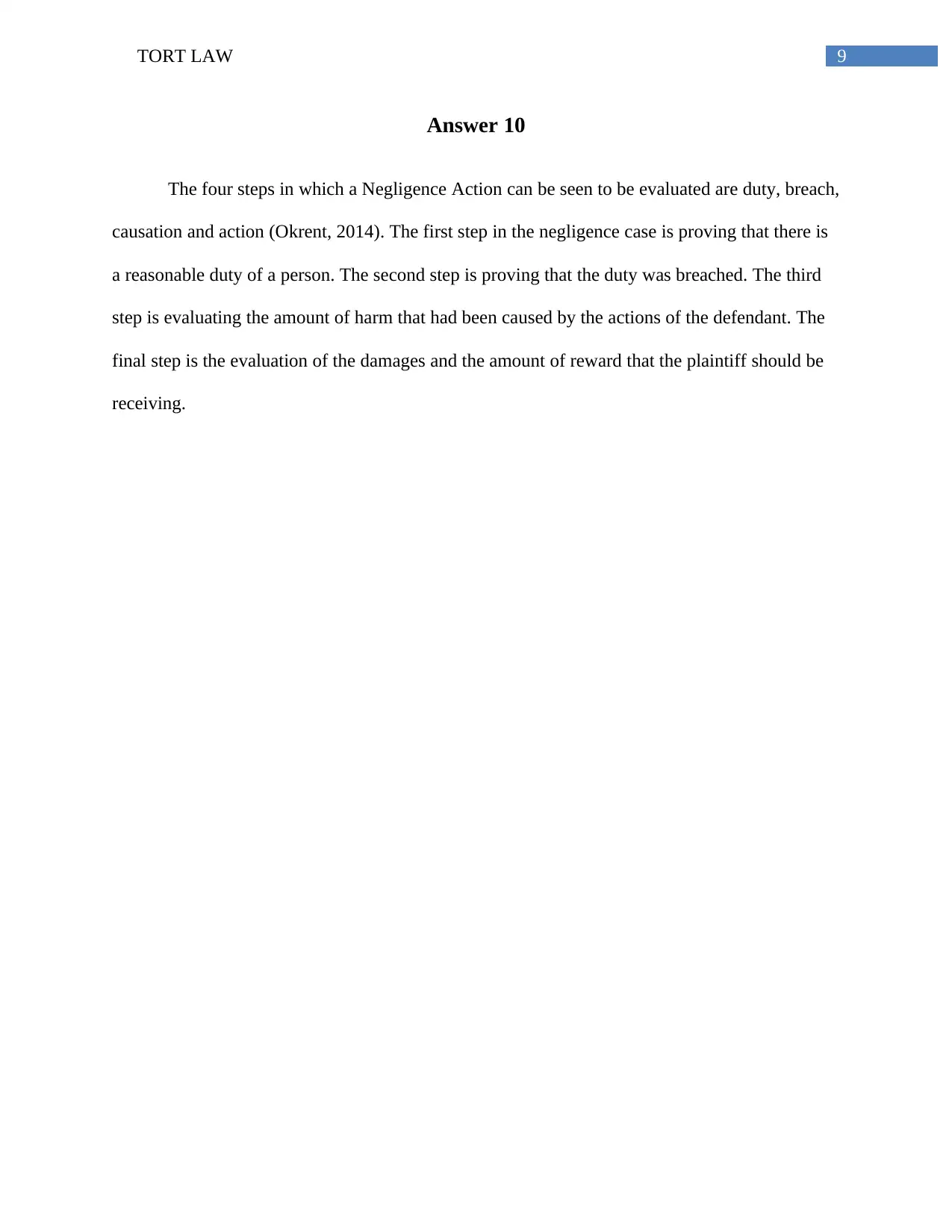
9TORT LAW
Answer 10
The four steps in which a Negligence Action can be seen to be evaluated are duty, breach,
causation and action (Okrent, 2014). The first step in the negligence case is proving that there is
a reasonable duty of a person. The second step is proving that the duty was breached. The third
step is evaluating the amount of harm that had been caused by the actions of the defendant. The
final step is the evaluation of the damages and the amount of reward that the plaintiff should be
receiving.
Answer 10
The four steps in which a Negligence Action can be seen to be evaluated are duty, breach,
causation and action (Okrent, 2014). The first step in the negligence case is proving that there is
a reasonable duty of a person. The second step is proving that the duty was breached. The third
step is evaluating the amount of harm that had been caused by the actions of the defendant. The
final step is the evaluation of the damages and the amount of reward that the plaintiff should be
receiving.
Paraphrase This Document
Need a fresh take? Get an instant paraphrase of this document with our AI Paraphraser
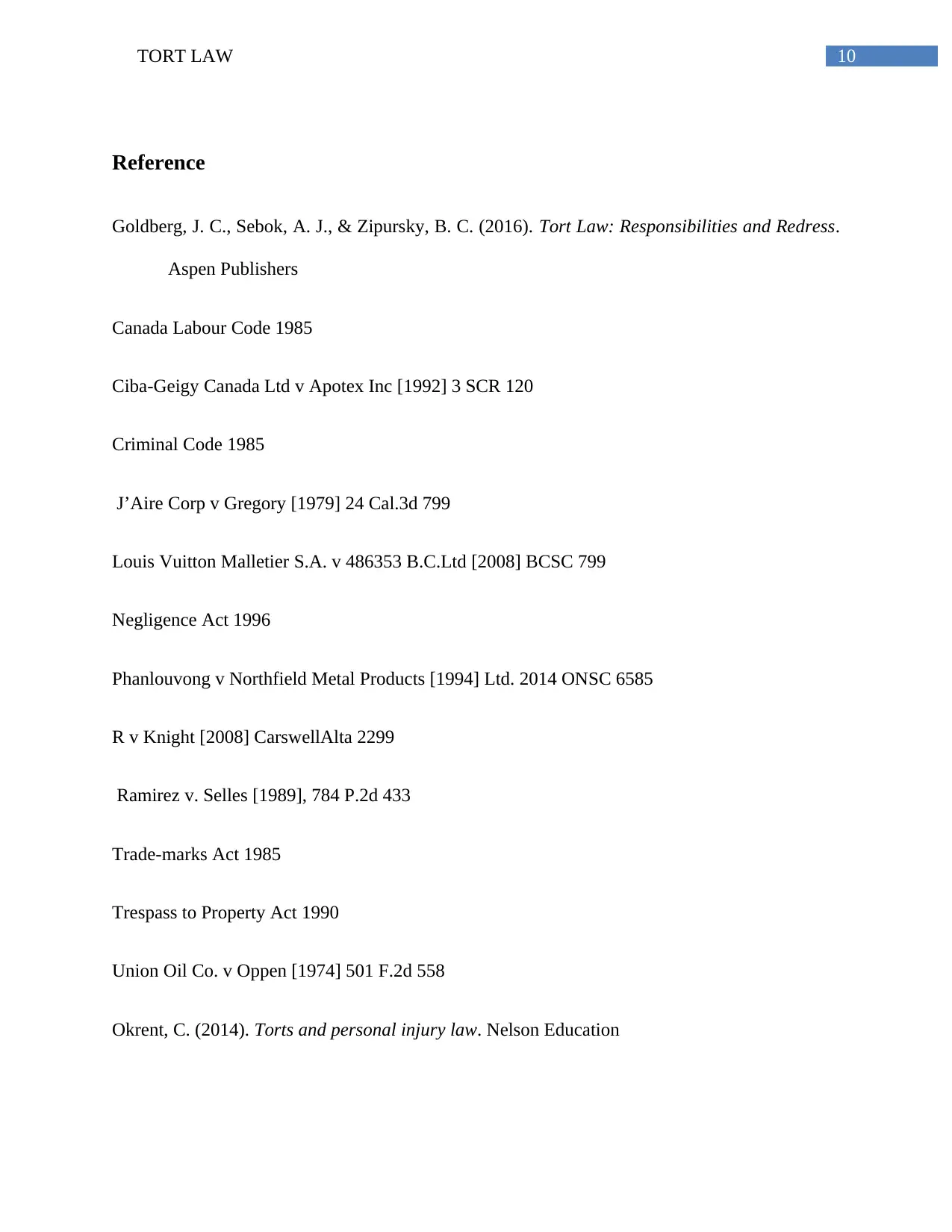
10TORT LAW
Reference
Goldberg, J. C., Sebok, A. J., & Zipursky, B. C. (2016). Tort Law: Responsibilities and Redress.
Aspen Publishers
Canada Labour Code 1985
Ciba-Geigy Canada Ltd v Apotex Inc [1992] 3 SCR 120
Criminal Code 1985
J’Aire Corp v Gregory [1979] 24 Cal.3d 799
Louis Vuitton Malletier S.A. v 486353 B.C.Ltd [2008] BCSC 799
Negligence Act 1996
Phanlouvong v Northfield Metal Products [1994] Ltd. 2014 ONSC 6585
R v Knight [2008] CarswellAlta 2299
Ramirez v. Selles [1989], 784 P.2d 433
Trade-marks Act 1985
Trespass to Property Act 1990
Union Oil Co. v Oppen [1974] 501 F.2d 558
Okrent, C. (2014). Torts and personal injury law. Nelson Education
Reference
Goldberg, J. C., Sebok, A. J., & Zipursky, B. C. (2016). Tort Law: Responsibilities and Redress.
Aspen Publishers
Canada Labour Code 1985
Ciba-Geigy Canada Ltd v Apotex Inc [1992] 3 SCR 120
Criminal Code 1985
J’Aire Corp v Gregory [1979] 24 Cal.3d 799
Louis Vuitton Malletier S.A. v 486353 B.C.Ltd [2008] BCSC 799
Negligence Act 1996
Phanlouvong v Northfield Metal Products [1994] Ltd. 2014 ONSC 6585
R v Knight [2008] CarswellAlta 2299
Ramirez v. Selles [1989], 784 P.2d 433
Trade-marks Act 1985
Trespass to Property Act 1990
Union Oil Co. v Oppen [1974] 501 F.2d 558
Okrent, C. (2014). Torts and personal injury law. Nelson Education

11TORT LAW
⊘ This is a preview!⊘
Do you want full access?
Subscribe today to unlock all pages.

Trusted by 1+ million students worldwide
1 out of 12
Related Documents
Your All-in-One AI-Powered Toolkit for Academic Success.
+13062052269
info@desklib.com
Available 24*7 on WhatsApp / Email
![[object Object]](/_next/static/media/star-bottom.7253800d.svg)
Unlock your academic potential
Copyright © 2020–2025 A2Z Services. All Rights Reserved. Developed and managed by ZUCOL.





